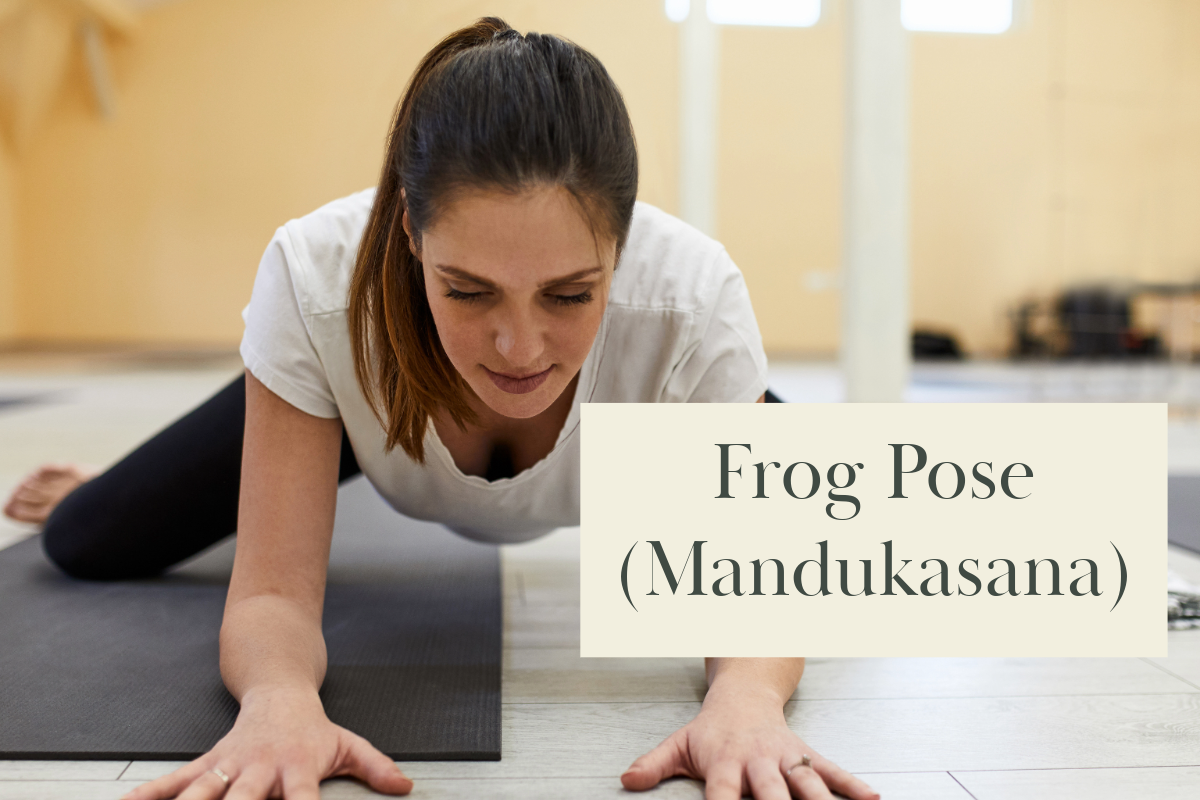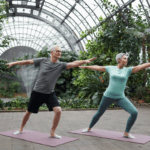Coming Soon: E-book about Kundalini Yoga - Sign up here to be among the first to get it!
The frog pose transcends a mere yoga position, serving as an avenue to heightened limberness, clearer thinking, and superior health. Delving into the core of frog pose, this piece unveils its roots, furnishes detailed instructions for its safe execution, and suggests adaptations suitable for diverse physiques. Diving into routine engagement, we uncover the power to bolster bodily vigor and mitigate ailments such as type 2 diabetes by enhancing blood flow and diminishing stress. Moreover, we offer handy advice on seamlessly incorporating frog pose into your everyday yoga practice, steering clear of typical blunders that might result in harm. Finishing this guide, you’ll grasp the full spectrum of advantages frog pose offers and discover tailored strategies to seamlessly incorporate it into your lifestyle.
Table Of Contents:
- Understanding Frog Pose: An Overview
- Step-by-Step Guide to Perfecting Frog Pose
- Modifications & Variations for Every Body
- The Health Benefits of Regular Frog Pose Practice
- Safety Precautions When Practicing Frog Pose
- Integrating Frog Pose into Your Yoga Routine
- Frog Pose’s Role in Managing Chronic Conditions
- Mistakes to Avoid for Effective Frog Pose Practice
- FAQs about Frog Pose (Mandukasana)
- Conclusion
Understanding Frog Pose: An Overview
Frog pose, or Mandukasana in Sanskrit, is a key yoga pose known for its deep hip opening and flexibility benefits. By adopting the frog stance, one engages not just the hips but also delves into stretching the inner thighs, groin area, and fortifies the core.
The Anatomy of Frog Pose
By adopting the frog stance, you’re essentially activating a variety of muscles pivotal for enhancing the flexibility and movement within your hips. Diving into frog pose, you’re not just limbering up those inner thigh and groin areas but also giving your core a serious workout to keep yourself steady. Hip openers like this are essential for anyone looking to improve their overall flexibility and reduce muscle tightness around the hips.
Adopting this specific pose in your yoga practice can alleviate the strain frequently felt from prolonged sitting or repetitive activities, targeting commonly stiff regions. If you’re someone who struggles with knee pain or stiffness in your lower back, incorporating frog pose into your routine can offer relief by gently easing pressure off these areas.
Historical Roots of Mandukasana
The origins of frog pose stretch back to ancient yogic traditions where it was used not only as a physical exercise but also as a means to prepare the body comfortably for deeper meditation practices. Its name ‘Mandukasana’ translates directly to ‘frog’, reflecting the position’s resemblance to how frogs naturally rest with their legs splayed outwards.
Much more than just an exercise for physical health; this yoga practice carries historical significance within spiritual contexts too. It serves as a bridge connecting one’s present state with age-old wisdom aiming at harmonizing body and mind through focused breathing (diaphragmatic breathing) techniques coupled with precise bodily alignments.
Step-by-Step Guide to Perfecting Frog Pose
Entering Frog Pose Safely
To safely get into frog pose, start by positioning yourself on your yoga mat in a tabletop position with palms flat and knees beneath your hips. Gently bring your knees wider apart while keeping the insides of your feet touching the ground; toes should be pointing outward. Slowly slide down until you feel a deep stretch but no pain. This initial setup is crucial for avoiding knee strain and maintaining a neutral spine, both key components of proper form.
Frog pose can sometimes lead to discomfort if not entered correctly, so it’s important to pay attention to how each part of your body feels as you move into this hip opener. If you experience any sharp pain or excessive pressure on the knees or hips, consider using yoga blocks under your forearms for additional support.
Maintaining Alignment and Breathing
Once in frog pose, focus on keeping alignment by ensuring that hips are aligned with knees and ankles are in line with knees too – this prevents putting unnecessary stress on these joints. Engage belly breathing to help release tension from tight thigh muscles and groin area further promoting relaxation within the posture.
Taking deep breaths also helps maintain mental clarity during practice because it encourages diaphragmatic breathing which enhances overall lung capacity and relaxes the mind-body connection significantly aiding stress reduction efforts over time when practicing frog regularly alongside other yoga poses like child’s pose or happy baby for increased flexibility across various muscle groups including those hard-to-reach inner thighs and groin muscles known for holding onto emotional baggage according to some yogic traditions.
Modifications & Variations for Every Body
Frog Pose Modification
If the traditional frog pose feels too intense, consider using yoga blocks to support your body. Placing a block under each hip can reduce strain and let you ease into the stretch more comfortably. Adapting the frog pose with props proves especially beneficial for individuals aiming to enhance their flexibility or navigate around hip discomfort.
Another way to modify frog pose is by adjusting knee placement. If bringing your knees closer together reduces discomfort, start there and gradually work on widening your stance as your muscles release tension. Keep in mind, tuning into your body’s signals and adjusting movements to what feels best is essential.
Happy Baby Pose as an Alternative
For yogis looking for less intensity but similar benefits, happy baby pose offers a gentle alternative that still targets the hips groin muscles effectively. By lying on your back with knees bent towards the chest and hands holding onto the feet, this posture allows for deep hip opening without putting pressure on sensitive knees.
This variation not only improves mobility but also encourages diaphragmatic breathing which aids in releasing physical and mental stress. It’s generally safe even during pregnancy when many other poses might be off-limits.
To explore more about incorporating these modifications into practice visit our Yoga Hip Openers Library. Here you’ll find detailed guides on executing variations safely while reaping all associated health benefits such as increased flexibility, improved posture, and enhanced mental clarity.
Keep in mind, the essence of yoga is to bring comfort and joy to your being. Making small adjustments ensures that every session enhances both mind-body wellness regardless of where you are in your yoga journey.
The Health Benefits of Regular Frog Pose Practice
Enhancing Physical Flexibility and Strength
Frog pose, or Mandukasana as it’s known in traditional yoga practices, targets your hips, inner thighs, groin muscles, and core. This profound hip stretch helps alleviate the stiffness frequently gathered from extended periods of sitting or vigorous exercise, thereby enhancing flexibility in the hips. Strengthening and enhancing flexibility in your hips, inner thighs, groin muscles, and core isn’t merely for show; it’s crucial for maintaining a harmonious bodily equilibrium and an upright posture.
One significant benefit many find surprising is its ability to ease back pain. The connection between flexible hips and a comfortable back may not be obvious at first but think of your body as an interconnected system where improvement in one area often benefits others.
To get the most out of frog pose variations for both beginners and advanced practitioners alike, explore modifications here. Whether you’re using props like yoga blocks or adjusting knee placement to suit your level of comfort, remember: listening to your body is crucial.
Mental Clarity and Stress Reduction
Beyond the physical benefits lie equally important mental health perks. Practicing frog pose encourages diaphragmatic breathing—or belly breathing—which promotes relaxation and stress reduction. This type of breath work helps activate the parasympathetic nervous system (think ‘rest-and-digest’), which plays a critical role in managing anxiety levels.
Adding yoga to your daily habits can not only dial down tension but also keep blood sugar in check, an advantage especially valuable for individuals grappling with type 2 diabetes. Learn more about yoga’s role in regulating blood sugar here.
Safety Precautions When Practicing Frog Pose
Engaging in Frog Pose, celebrated for its profound ability to expand the hips, could revolutionize your approach to yoga. But like any yoga pose, it comes with the need for caution to avoid injury, especially if you have sensitive knees or are pregnant. Here’s how to stay safe.
Entering Frog Pose Safely
To start off on the right foot—or knee—make sure your body is properly warmed up before attempting frog pose. This might mean doing some gentler hip openers or spending a few minutes with dynamic movements that get blood flowing to your hips and thighs. If you’ve been sitting for long hours before your session, this step becomes even more crucial.
When you’re ready to enter the pose, use a yoga mat or another soft surface beneath you. To shield your knees from the unforgiving ground, it’s wise to position yourself on a forgiving surface. For extra cushioning and support under your knees or hands, consider placing folded blankets or using yoga blocks. Pregnant women should pay particular attention here; modifying the position by keeping their knees closer together can help maintain balance and comfort.
Maintaining Alignment and Breathing
Mastering frog pose safely hinges on proper alignment and mastering your breathing technique. Keeping a neutral spine and aligning your hips directly over your knees prevent undue strain on both joints. Breathe deeply throughout, letting each exhale gently deepen into the stretch without forcing it.
If at any point during frog pose yoga you feel pain—not just discomfort but actual pain—it’s time to back off. This could indicate too much pressure on either the hips or knees. Rather than pushing through, the safer choice is always to ease out of the posture, and perhaps try again another day with additional modifications or after further conditioning and flexibility work has been undertaken.
Frog pose is your ticket to deeper hip flexibility, but don’t rush it. Warm up first, pad those knees, and listen to your body—especially if you’re pregnant or have sensitive joints. Ease into the stretch with care for a safe and beneficial practice.
Integrating Frog Pose into Your Yoga Routine
Maintaining this stance for a minimum of half a minute not only focuses on the hips but also engages the inner thigh and groin areas, proving to be a vital component in routines aimed at increasing suppleness.
Entering Frog Pose Safely
To start incorporating frog pose into your daily or weekly yoga sessions safely, first make sure you’re warmed up. A gentle sequence that includes poses like child’s pose and happy baby will prepare your body comfortably for the deeper stretch of frog pose. As you move into the position from a tabletop stance on your yoga mat, pay attention to how your knees feel; use props like a folded blanket beneath them if necessary.
Maintaining alignment is crucial as well. Keep your knees in line with your hips as you slowly slide them wider apart until you feel a deep yet manageable stretch in the hips and groin area. If there’s pain or discomfort beyond mild stretching sensations, gently bring your knees closer together again.
Maintaining Alignment and Breathing
Breath control plays a pivotal role while holding frog pose yoga positions since breathing deeply helps release muscle tightness more effectively. Place palms flat on the ground beneath shoulders to maintain stability; focus on diaphragmatic breathing techniques such as belly breathing to deepen relaxation throughout the hold time.
Achieving proper form means avoiding common mistakes—like letting one’s back arch excessively or allowing knees to splay out too far—which could otherwise lead to strain rather than benefiting from increased flexibility and strength offered by regular yoga practice with correct posture emphasized during each session.
Slide into frog pose to open up your hips and boost flexibility. Start warmed up, use props if needed, keep knees aligned, and breathe deep to ease into the stretch safely.
Frog Pose’s Role in Managing Chronic Conditions
Employing yoga as a strategy for chronic ailment control reveals that the frog stance, known formally as Mandukasana, is notably efficacious in this regard. By delving into the profound hip-stretching Mandukasana, practitioners don’t merely ease their hips but also engage the muscles of their inner thighs and groin, thereby playing a crucial role in enhancing blood flow and alleviating tension.
Holding Yoga Moves like Frog Pose for 30 Seconds Can Help Regulate Blood Sugar Levels in Type 2 Diabetes Patients
Type 2 diabetes patients often struggle with maintaining stable blood sugar levels. Regularly incorporating yin yoga interventions, including the frog pose, into one’s routine can significantly aid this battle. By holding poses like Mandukasana for at least thirty seconds, you encourage better circulation throughout your body. Improved circulation then plays a key role in helping regulate blood sugar levels by ensuring insulin works more efficiently.
Moreover, practicing such poses aids in releasing tension from muscle groups that are typically tight due to long hours of sitting or standing. The relaxation achieved through these positions further contributes to reducing stress levels—a common trigger of elevated blood sugar.
The Connection Between Stress Reduction and Circulation Improvement Through Frog Pose Practice
Mental health intricately connects with our physical well-being; hence practices that promote mental clarity indirectly benefit our bodily functions too. Engaging regularly in frog pose has shown promising results not only in easing back pain but also as an effective method to manage anxiety and enhance overall mood stability thanks to its calming effect on the mind.
This combined impact on both psychological health through stress reduction and physiological health via improved circulation underscores why integrating Mandukasana into daily or weekly routines could be particularly beneficial for individuals dealing with type 2 diabetes or similar chronic conditions.
Frog pose is a game-changer for managing chronic conditions like type 2 diabetes. It opens hips, improves circulation, and reduces stress by holding the position for at least 30 seconds. This simple practice can make insulin more effective and lower blood sugar levels while easing muscle tension and boosting mental health.
Mistakes to Avoid for Effective Frog Pose Practice
When you’re practicing frog pose, it’s easy to fall into common pitfalls that can lead to strain or injury. To enhance your frog pose, sidestep these critical blunders.
Forgetting to Breathe Deeply
In the midst of yoga, particularly during challenging hip stretches such as the frog position, ensuring you’re taking deep breaths is essential. Aiding in the easing of strain and enhancing the flexibility safely, deep inhalation is a key component. Many practitioners hold their breath when they feel discomfort, but this forgotten breath can hinder progress and increase muscle tightness. Incorporating diaphragmatic breathing allows your body to comfortably move deeper into poses over time.
To maintain focus on your breathing, try setting a slow rhythm before starting and keep it throughout the pose.
Forcing Your Knees Apart
Aiming for an overly wide stance too soon is another common mistake. Pushing your knees apart aggressively can cause unnecessary strain on your hips and groin muscles rather than gently opening them up. Listen closely; if you start feeling pain instead of a stretch, bring your knees closer together immediately.
Injury avoidance starts with respecting our current limits while gradually working towards greater flexibility and strength within those boundaries.
Safety first: If you have sensitive knees or any hip injuries, learn more about protecting these areas during practice. Remember that not all bodies are ready for every position right away — using modifications like placing cushions under your knees or performing variations such as happy baby pose might be necessary steps toward safely achieving full frog pose mastery.
FAQs about Frog Pose (Mandukasana)
What is the frog pose good for?
Frog pose opens your hips, stretches inner thighs, and eases tight muscles. It’s a top pick for flexibility.
Why is frog pose so difficult?
Frog pose challenges because it demands deep hip and thigh flexibility many of us lack from sitting all day.
How to do frog pose for beginners?
Start on hands and knees. Gently widen knees until you feel a stretch, keeping feet in line with knees. Breathe.
How long should you stay in frog pose?
Aim to hold frog pose for 30 seconds to 1 minute at first. Gradually increase as your comfort grows.
Conclusion
Embarking on the frog pose journey not only opens the door to enhanced hip limberness but also ushers in a serene state of mind. From its deep roots in yoga traditions to the careful alignment of each muscle, this guide has walked you through every step.
Remember: start slow, breathe deeply, and always listen to your body. Modifications are there for a reason—use them. Whether it’s easing into frog pose with blocks or adjusting knee placement, find what feels right.
Consistency is key. Steadily engaging in your routine not only enhances the way you carry yourself but also helps in controlling ailments such as diabetes through the stabilization of glucose concentrations.
Above all, safety first. Pay attention to your body’s signals and avoid pushing too hard too soon.
Embrace frog pose as more than an exercise—it’s a journey towards balance and well-being that starts on the mat.
Sign up for our newsletter to stay updated with the latest articles, or ask me anything!




